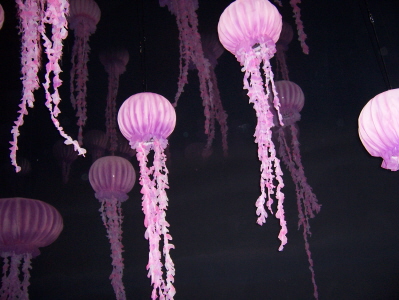Obama May Bring Change, But Jellyfish Bring Security

Recent development in biosensor technology has improved defense against bioterrorism. Scientists injected Jellyfish DNA into mouse cell nuclei. The cells were manipulated to react to specific pathogens. Select stimuli, like dangerous biological agents, cause the cells to react in a manner ideal for detection. The cells release photons of light when they come in contact with a molecule of interest that is in the tested air. The device, called PANTHER, washes the cells with air and uses detectors to read the light released by the cells. Panther is capable of outputting a list of hazards, because cells are altered differently to detect a variety of pathogen. It is at least ten times faster than any other devices that serve a similar purpose.
The article says little about why jellyfish DNA is used or why they are injected into mouse cell lines. Perhaps jellyfish DNA can easily be manipulated to serve the purposes of these scientists, more so than mouse DNA. Maybe jellyfish DNA is already well tuned into detecting pathogens similar to the ones used in biological warfare.
-Posted by Jordan Grinstein

18 Comments:
Where was this development in biosensor technology developed? What are the detectors that the PANTHER device uses to read the light released by the cells?
Is PANTHER the only device used in biosensor technology? Is PANTHER used universally at places that are categorized as potential terrorist targets?
SUSAN DUONG
they only thing i have Evey heard that is close to this is using DNA fragments of agents to conduct current and detect contamination. but this seem way cheaper.
-Matthew Sousa
I understand the principle of jellyfish cells glowing and I can also see the logic behind injecting their DNA into mouses- what baffles me is the device itself. How do the mouse cells end p in the machine, how are they sustained in it and how are the discs mentioned in the article used to connect everything?
Noam Pelleg
11/8/08
This is a neat new technology. I assume they use the jellyfish DNA for their glowing properties. You mentioned that the device can detect several pathogens, but how many can each mouse react to?
Allison Cornell (8)
The fact that the PANTHER device proves much more efficient than the existing technology is definitely a good indication of the advancements in technologies over the years. Does the PANTHER device detect an expansive amount of biological agents in comparison to the devices that existed previous to this technology? It is interesting that jellyfish DNA is used in mouse cell lines; could this be because the jellyfish and the mouse have a somewhat similar DNA sequence?
-Helen Thi
I just don't understand how putting jellyfish DNA into a mouse can prove effective. They are two completely different species and i don't know exactly where they are going with it.
Amanda Joyce
Interesting article! It is fascinating that the cells in jelly fish can detect pathogens by giving off light. So, how does this prevent against bioterrorism if it only detects certain pathogens? Good write up, I would like to know more.
-Carlos A. Varela
This is definitely an interesting new technology. How are the mouse cells ending up in the PANTHER device once a pathogen is detected?
~Dan Hong
This is a very interesting use of jellyfish DNA. It amazes me what a simple organism, such as a jesllyfish, can lead to so much. I assume that there needs to be more research in this.
Duy Nguyen
I like the title but I don't understand much of what it going on in the article. I am definitely interested in knowing more but there it not much information here about the "why" or "how".
Sarah Moltzen
I know that little provided in the article you read, but perhaps it has something to do with the bio-luminance that some marine life exhibit. And since some jellyfish have this, a certain wavelength of light that is released when they come in contact with a pathogen will correspond to the pathogen that you are looking for.
Stephen Lee
I don't understand the application for bio terrorism. How will they apply the research to real life situations?
Jimmy Sullivan
This biosensor technology is very interesting and i'm curious as to what other situations this can be applied to. Can this possibly pick up on contamination in the air?
Ahmed Sandakli
interesting, i wonder if someday the dna can be tested on animals like canines, maybe it would make them more efficient.
Hessom Minaei
This is an interesting article Jordan! It is pretty cool that the cells in jelly fish can detect pathogens. But, how does this prevent against bioterrorism if it only detects certain pathogens? How are scientists going to use this technology to fight bioterrorism?
Brena Sena
What is the environment in which these bio-sensors are intended to be used in. Are the jellyfish being taken out of the water to test for air pathogens, or are they only being used in the water? If this is the case what are the plans to move these sensors to be used in different environments?
Alex Jackson
This is so interesting! I wonder if there are any negative side affects for the mice though. I wonder too how they would track and actually use these mice...good work!
Ericka Adey
It seems like a pretty neat thing. Maybe because I don't fully understand the concept but it seems like it would be hard to narrow a specific problem down with just light .
Charles Scondras
Post a Comment
<< Home